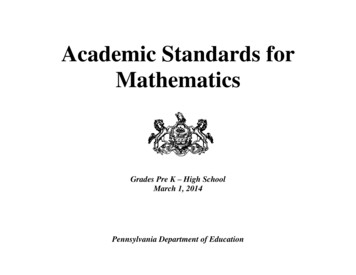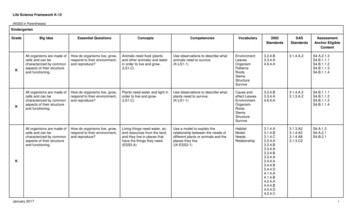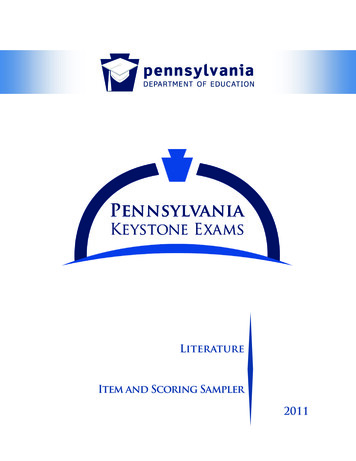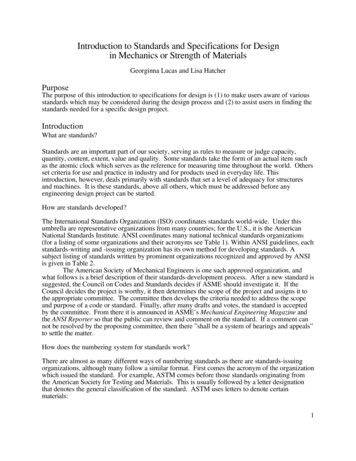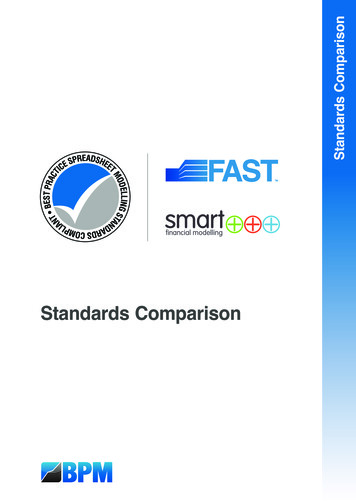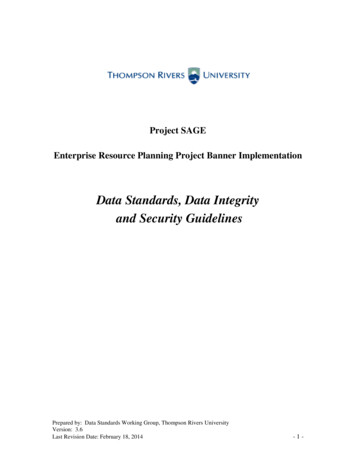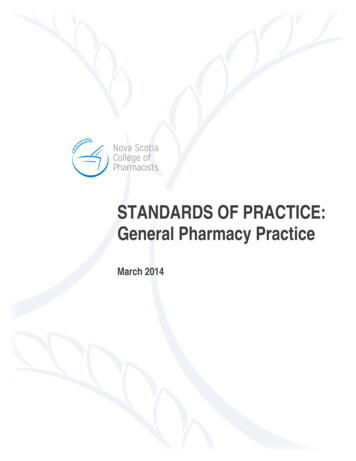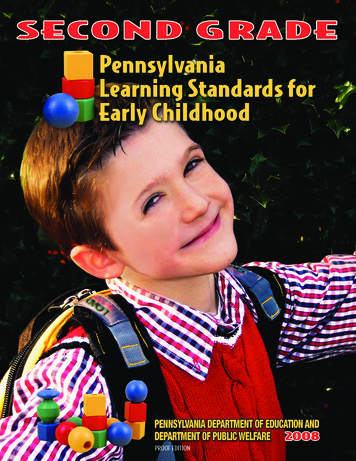
Transcription
PROOF EDITION
Introduction . . . . . . . . . . . . . . . . . . . . . . . . . . . . . . . . . . . . . . . . . . . . 2Guiding Principles . . . . . . . . . . . . . . . . . . . . . . . . . . . . . . . . . . . . . . . 4Key Learning Area:Health, Safety and Physical Education . . . . 21Key Learning Area:Approaches to Learning . . . . . . . . . . . . . . . . 5Standard AL 1 :Standard AL 2:Standard AL 3:Standard AL 4:Standard AL 5:Initiative and Curiosity . . . . . . . . . . . . . . . . . . . . 6Engagement and Persistence . . . . . . . . . . . . . . . 6Reasoning and Problem Solving . . . . . . . . . . . . 7Flexibility, Risk-Taking and Responsibility . . 8Imagination, Creativity and Invention . . . . . . . 8Standard 10.1:Standard 10.2:Standard 10.3:Standard 10.4:Standard 10.5:Concepts of Health. . . . . . . . . . . . . . . . . . . . . . . 22Healthful Living . . . . . . . . . . . . . . . . . . . . . . . . . 24Safety and Injury Protection . . . . . . . . . . . . . . 26Physical Activity. . . . . . . . . . . . . . . . . . . . . . . . . 27Concepts, Principals andStrategies of Movement . . . . . . . . . . . . . . . . . . 29Key Learning Area:Mathematics . . . . . . . . . . . . . . . . . . . . . . . . . 31Key Learning Area:Arts and Humanities . . . . . . . . . . . . . . . . . . . 9Standard 9.1:Production, Performance and Exhibition ofDance, Music, Theatre and Visual Arts. . . . . . . 10Standard 9.2: Historical and Cultural Contexts. . . . . . . . . . . . 14Standard 9.3: Critical Response. . . . . . . . . . . . . . . . . . . . . . . . . 15Standard 9.4: Aesthetic Response . . . . . . . . . . . . . . . . . . . . . . 16Key Learning Area:Family-SchoolCommunity Partnerships . . . . . . . . . . . . . . . 17Standard P1:Standard P2:Standard P3:Standard P4:Standard P5:Standard P6:Parenting . . . . . . . . . . . . . . . . . . . . . . . . . . . . . . . 18Communication. . . . . . . . . . . . . . . . . . . . . . . . . . 18Volunteering . . . . . . . . . . . . . . . . . . . . . . . . . . . . 19Learning at Home . . . . . . . . . . . . . . . . . . . . . . . . 19Decision Making. . . . . . . . . . . . . . . . . . . . . . . . . 20Collaborating with the Community . . . . . . . . 20Standard 2.1: Numbers, Number Systems andNumber Relationships. . . . . . . . . . . . . . . . . . . . 32Standard 2.2: Computation and Estimation . . . . . . . . . . . . . . 33Standard 2.3: Measurement and Estimation. . . . . . . . . . . . . . 34Standard 2.4: Mathematical Reasoning and Connections . . . 35Standard 2.5: Mathematical Problem Solvingand Communication . . . . . . . . . . . . . . . . . . . . . . 35Standard 2.6: Statistics and Data Analysis. . . . . . . . . . . . . . . 36Standard 2.7: Probability and Predictions . . . . . . . . . . . . . . . 36Standard 2.8: Algebra and Functions. . . . . . . . . . . . . . . . . . . . 38Standard 2.9: Geometry . . . . . . . . . . . . . . . . . . . . . . . . . . . . . . 39Standard 2.10: Trigonometry . . . . . . . . . . . . . . . . . . . . . . . . . . . 40Standard 2.11 Calculus. . . . . . . . . . . . . . . . . . . . . . . . . . . . . . . . 40Key Learning Area:Personal Social . . . . . . . . . . . . . . . . . . . . . . . 41Standard PS 1:Standard PS 2:Standard PS 3:Standard PS 4:Develop Self Concept. . . . . . . . . . . . . . . . . . . . . 42Develop Self Regulation . . . . . . . . . . . . . . . . . . 42Develop Social Interactions . . . . . . . . . . . . . . . 43Develop Care and Self Reliance . . . . . . . . . . . . 43
Key Learning Area:Reading, Writing, Speakingand Listening . . . . . . . . . . . . . . . . . . . . . . . . 44Standard 1.1:Standard 1.2:Standard 1.3:Standard 1.4:Standard 1.5:Standard 1.6:Standard 1.7:Standard 1.8:Learning to Read Independently . . . . . . . . . . . 45Reading Critically in all Content Areas . . . . . . 48Reading, Analyzing and InterpretingLiterature . . . . . . . . . . . . . . . . . . . . . . . . . . . . . . 49Types of Writing . . . . . . . . . . . . . . . . . . . . . . . . 50Quality of Writing. . . . . . . . . . . . . . . . . . . . . . . . 51Speaking and Listening . . . . . . . . . . . . . . . . . . . 53Characteristics and Functionsof the English Language . . . . . . . . . . . . . . . . . . 54Research . . . . . . . . . . . . . . . . . . . . . . . . . . . . . . . 54Key Learning Area:Science . . . . . . . . . . . . . . . . . . . . . . . . . . . . . . 55Science and TechnologyStandard 3.1: Unifying Themes . . . . . . . . . . . . . . . . . . . . . . . . 56Standard 3.2: Inquiry and Design . . . . . . . . . . . . . . . . . . . . . . 58Standard 3.3: Biological Sciences . . . . . . . . . . . . . . . . . . . . . . 59Standard 3.4: Physical Sciences, Chemistry and Physics. . . 60Standard 3.5: Earth Sciences . . . . . . . . . . . . . . . . . . . . . . . . . . . 61Standard 3.6: Technology Education . . . . . . . . . . . . . . . . . . . . 62Standard 3.7: Technological Devices . . . . . . . . . . . . . . . . . . . . 63Standard 3.8: Technology and Human Endeavors . . . . . . . . . 63Environment and EcologyStandard 4.1: Watersheds and Wetlands . . . . . . . . . . . . . . . . 64Standard 4.2: Renewable and Nonrenewable Resources . . . 65Standard 4.3: Environmental Health . . . . . . . . . . . . . . . . . . . . 67Standard 4.4: Agriculture and Society . . . . . . . . . . . . . . . . . . 68Standard 4.5: Integrated Pest Management. . . . . . . . . . . . . . 69Standard 4.6: Ecosystems and Their Interactions . . . . . . . . . 70Standard 4.7: Threatened, Endangered and Extinct Species . . 71Standard 4.8: Humans and the Environment . . . . . . . . . . . . . 72Standard 4.9: Environmental Laws and Regulations . . . . . . . 72Key Learning Area:Social Studies . . . . . . . . . . . . . . . . . . . . . . . . 73Civics and GovernmentStandard 5.1: Principles and Documents of Government . . . 74Standard 5.2: Rights and Responsibilities of Citizenship . . . 75Standard 5.3: How Government Works. . . . . . . . . . . . . . . . . . 76EconomicsStandard 6.1:Standard 6.2:Standard 6.3:Standard 6.4:Standard 6.5:GeographyStandard 7.1:Standard 7.2:Economic Systems . . . . . . . . . . . . . . . . . . . . . . . 77Markets and the Functions of Governments . 78Scarcity of Choice. . . . . . . . . . . . . . . . . . . . . . . . 79Economic Interdependence. . . . . . . . . . . . . . . . 80Work and Earnings . . . . . . . . . . . . . . . . . . . . . . . 81Standard 7.4:Basic Geography Literacy . . . . . . . . . . . . . . . . . 81The Physical Characteristics of Placesand Regions . . . . . . . . . . . . . . . . . . . . . . . . . . . . 82The Human Characteristics of Placesand Regions . . . . . . . . . . . . . . . . . . . . . . . . . . . . 82The Interaction Between People and Places . 83HistoryStandard 8.1:Standard 8.2:Standard 8.3:Standard 8.4:Historical Analysis and Skills Development . 83Pennsylvania History . . . . . . . . . . . . . . . . . . . . 84United States History. . . . . . . . . . . . . . . . . . . . 84World History. . . . . . . . . . . . . . . . . . . . . . . . . . . 85Standard 7.3:Appendix . . . . . . . . . . . . . . . . . . . . . . . . . . . . . . . . . . . . . . . . . . . . . 86Glossary . . . . . . . . . . . . . . . . . . . . . . . . . . . . . . . . . . . . . . . . . . . . . . 87Pennsylvania’s Primary Standards for grade 2 weredeveloped by the Department of Education and Welfarein support of Governor Rendell’s commitment to earlychildhood education. The Primary Standards for grade 2are meant to guide the development of primary ageprograms throughout the state. A Task Force consisting ofearly childhood practitioners, primary teachers, schooladministrators, policy analysts, researchers anduniversity faculty developed the standards.PENNSYLVANIA STANDARDS FOR 2ND GRADE (PROOF EDITION)1
he Commonwealth of Pennsylvania has established highacademic standards for all students pre-K through grade12. Research-based standards are the key to laying astrong academic foundation that will provide children with skillsnecessary to succeed in every phase of their lives.Standards-based practices maximize student learning byaligning standards for both instruction and assessment in thefollowing ways: guiding teachers’ deliberate and intentional instructionalpractice, supporting effective classroom environments and framing teachers’ age-appropriate expectations for theirstudentsA smooth transition from one grade to the next is critical to building solid learning foundations in the primary grades. Research hasshown the value of active learning for both cognitive and socialdevelopment in these grades. Children learn key skills of literacy,number sense, science and social problem solving both throughshared explorations and direct instruction. They best developtheir understanding of the world around them and how it relatesto them by interacting with materials, other children, their teacherand the community.Primary classrooms, supported by the use of standards,facilitate children’s learning across key curricular areas,emphasizing a variety of rigorous literacy, science (inquiry-based),number sense and social experiences. They provide primarychildren with opportunities to construct knowledge and meaningthrough active, hands-on/minds-on exploration in a variety ofindoor and outdoor experiences that include large and small group,individual and partner-based instructional practices.The most effective methods utilized by primary teachers shouldinclude explicit instructional language, active engagement withchildren and differentiated instruction that meets the needs of alllearners while supporting high quality expectations.The learning behaviors that assure school success include: listening participation task persistence self-regulation making choices exhibiting self-control organization cooperation collaboration respecting the rights, feelings and property of othersTeachers can support children’s individualized learning opportunities by providing them with meaningful experiences that engagetheir interests, abilities and cultures. Teachers who have clear,age-appropriate expectations for children’s behavior provide abalance of independence and guidance.Approaches to LearningThe goal of the primary standards for grades 1 and 2 is to promotethe development of a child who has the attributes of: inventiveness, curiosity, persistence, engagement, reasoning, problemsolving, responsibility, imagination and creativity. To assist thechild in obtaining these attributes, the adult should approach thechild’s learning through actions that encourage the child dict2PENNSYLVANIA STANDARDS FOR 2ND GRADE (PROOF tLeadConcludeQuestionDeductDebate
Classroom environments should stimulatethe primary child’s curiosity, initiative andinquiry and foster opportunities foradult-student interaction. Classroomsshould be organized and structured tosupport all areas of development through arange of instructional techniques andstrategies, be rich in literacy and integrateliteracy and numeracy throughout the day.They should provide children with a safe, comfortable atmospherewhere they can practice newly acquired skills and build on them tolearn new information. The classroom environment shouldaccommodate active and quiet activities. It should offeropportunities for solitary, parallel and group interactionobservable by an adult.In addition to a robust set of standards to guide practice,primary programs should utilize a system of assessment that isvalid and reliable, comprehensive, developmentally appropriateand linguistically responsive in order to document a child’s growthand development, including the language proficiency of secondlanguage learners, in relation to a defined set of standards. Theassessment then becomes the mechanism to inform and supportinstruction.Teachers must be trained specifically to understand earlychildhood development, which is the responsibility of theinstitutions of higher learning. There should be a strong bondbetween the colleges and school districts in providingopportunities for student teaching experiences, being cognizantthrough ongoing dialogue and feedback of what the specificcurricular requirements/standards are and how to achieve thosestandards in a classroom setting. Teachers with a strongbackground in early childhood education and child developmentcan best provide what children need to grow emotionally,physically and intellectually.Community leaders and policymakers need to be aware of theimportance of early childhood education and the standards forlearning. The success of the local education system begins in theearly years prior to a child entering the public school system.Local leaders need to understand the diversity of children, yetrealize the sense of urgency in assisting and supporting theeducation of young children.RATIONALE FOR PERSONAL/SOCIAL LEARNINGAND DEVELOPMENTAs a child participates in the ongoing classroom routine, thesocial curriculum supports the academic curriculum. The child whocan negotiate interactions with a variety of adults and peers isbetter equipped to take advantage of the new knowledge base.By following classroom routines and rules, the child moves fromwhole group to small group to independent work with confidenceand efficiency. This provides maximum opportunities for growthand development. By learning to negotiate conflicts and modifyhis/her behaviors, the child is better served in all environments.These standards provide direction for teachers to enhance thisimportant aspect of learning.RATIONALE FOR PARTNERSHIPSThe definition of partnership according to Webster is: “one ormore persons owning jointly a business and who shares the risksand profits of the company or firm.” All citizens in theCommonwealth are stakeholders in how effectively we areeducating our youth. The results impact families, communities,law enforcement agencies, social and health agencies, the jobmarket and both local and state government. The obviousresponsibility of a formal education has been assigned to the localschools. Children, however, are exposed to many other personaland cultural influences that impact learning. It is crucial todevelop a system of communication and contact with the variousparticipants who occupy a role in the development of a child.PENNSYLVANIA STANDARDS FOR 2ND GRADE (PROOF EDITION)3
igh quality primary programs offer learning opportunities that have a significant impact on the success of all children. A warm,responsive relationship with a highly trained teaching staff is foundational. It is expected that teachers will intentionallyintegrate developmental knowledge with the attitudes, skills and concepts that children need to make steady progress socially,emotionally, physically and cognitively. Outstanding primary programs maintain high expectations for all children using clearperformance standards. A continuous cycle of assessment, which is understood by the professional staff and families, must be utilized totrack progress and success.All children can learn and deserve theestablishment of high expectations that areappropriate for theirage and are culturallyand technologicallyappropriate for meetingindividual differences.High quality primary programs recognize andprovide for a broad spectrum of individualneeds in diverse populations of children,which include, but are not limited to: Englishlanguage learners, children with special needs,and children from diverse cultural backgroundsand socio-economic groups.Children learn bestthrough intentionally planned instructionand activities that enable them to constructknowledge through real life connections,peer interactions, meaningful & imaginativeexperiences and active engagement with theenvironment.High quality primary programs are defined bya set of comprehensive standards thatmaximize children’s growth and developmentthat increase their problem-solving abilitiesacross domains.The learning environment for young childrenstimulates and engages their curiosityabout the world around them and meetstheir physical, emotional and creative needswhereby the children feel safe and secure.Language and literacy (both reading andwriting) development is supported andintegrated throughout the day in all contentareas in the primary grades. Conceptualunderstandings in content areas and in earlyliteracy are interdependent and have sets ofskills that mutually support each other.Children’s development and learning isenhanced and supported when their teachers are knowledgeable about early childhood development, educational pedagogyand content. When teachers participate inongoing opportunities for quality professional development, work with children,families & communities and are intentionalin their relationships children benefit.High quality primary programs use anappropriate system of assessment thatdocuments children’s growth and developmentin relationship to a defined setof state-mandated standardsto guide teaching and learning.Children’s development,learning, knowledge and healthare enhanced when a strong partnershipexists between families, schools andcommunities.High quality primary programs have acollaborative relationship and ongoingcommunication to provide smooth transitions(between early care programs andKindergarten or first and then between firstand second grades) for children and familiesto assure continuity of learning.**Footnote: Young children with disabilities will meet standards consistent with their individualized education program (IEPs) goals developed by IEP teams inaccordance with the federal Individuals with Disabilities Improvement Act (IDEIA) and Pennsylvania’s Early Intervention Services System Act (Act 212 of 1990).English language learners will use the Pennsylvania ELF Standards to gain access to and meet the PA Academic Standards.4PENNSYLVANIA STANDARDS FOR 2ND GRADE (PROOF EDITION)
hildren must demonstrate proficiency in both academics and their approachto their learning environment. These approaches are most effectivelylearned in the context of an integrated effort involving parents, educators andmembers of the community. Theacquisition of these approaches is aStandardPagedevelopmental process thatencompasses an individual’s entireAL 1.1 - AL 1.7 Initiative and Curiosity . . . . . . . . . . . . . . . . . . . . 6lifetime. Teachers must help childrenAL 2.1 - AL 2.6 Engagement and Persistence. . . . . . . . . . . . . . . . 6feel successful by supporting andunderstanding their individualAL 3.1 - AL 3.8 Reasoning and Problem Solving . . . . . . . . . . . . . 7differences, allowing them to explorethe world in a safe and caringAL 4.1 - AL 4.4 Flexibility, Risk-Taking and Responsibility . . . 8environment and enhancing theirAL 5.1 - AL 5.2 Initiative, Creativity and Invention . . . . . . . . . . 8curiosity and knowledge aboutthe world in which they live.PENNSYLVANIA STANDARDS FOR 2ND GRADE (PROOF EDITION)5
APPROACHES TO LEARNINGSTANDARD AL 1: DEMONSTRATE INITIATIVE AND CURIOSITYCONTENT FOR 2ND GRADEAL 1.1 Participate willingly in variousexperiencesAL 1.2 Express choices/preferences duringconcrete, immediate, familiar andunfamiliar activitiesAL 1.3 Demonstrate growing eagerness andsatisfaction to discover and discuss agrowing range of topics, ideas andtasksEXAMPLESThe learner will: Independently choose to participate in atleast 90% of the available learningcenters including new experiences.SUPPORTIVE PRACTICEThe teacher will: Enhance learning centers and groupactivities to attract child participation andenhance learning. Independently choose new and differentmaterials to represent different thoughtsor feelings. Provide a classroom with clearly definedinterest areas and materials that invitechildren to explore, discover and create. Express preferences, wants and needs in amanner that is appropriate and consistent. Provide a variety of materials, art work,music, drama and photographs tostimulate experiences, knowledge,participation and interests.AL 1.4 Use multiple strategies and allavailable senses to explore and learnfrom the environment Participate in preferred and non-preferredactivities that match one’s developmentalstrengths, talents and interests.AL 1.5 Comment, predict and connect onevents or aspects of the environment Initiate group and individual activities ofchoice within familiar environment. Provide varied subject integratedactivities in the learning centers.AL 1.6 Ask questions and seek meaningfulinformation Join and leave group with ease as a leaderor a follower as the situation demands. Provide materials/activities appealing toa variety of senses, learning styles,technology and multiple intelligences forindividuals, small groups and larger groupexperiences.AL 1.7 Initiate social greetings and carryconversations Provide genre of reading materials. Ask open-ended and higher levelquestions to facilitate sharing, engage thelistener, seek meaningful information andextend learning.STANDARD AL 2: DEMONSTRATE ENGAGEMENT AND PERSISTENCECONTENT FOR 2ND GRADEAL 2.1 Demonstrate ability to complete avariety of tasks, activities, projectsand experiencesEXAMPLESThe learner will: Express choices, initiate, follow throughand complete activities and projects.SUPPORTIVE PRACTICEThe teacher will: Encourage and praise efforts and facilitateplanning and completion.AL 2.2 Demonstrate ability to set goals anddevelop and follow through on plans Find, choose and participate inappropriate, constructive and enjoyableways to occupy leisure time. Encourage and document sequentialprogress and effort.AL 2.3 Demonstrate ability to maintainfocus on a task, question, set ofdirections or interactions, despitedistractions and interruptionsAL 2.4 Accept environmental conditions andmaintain task orientation in aconstructive active environmentAL 2.5 Demonstrate the skills necessary forparticipating in a group orindependently Self-monitor behaviors to adapt tochanging situations. Initiate requests for factual information,stories, games and other learningactivities.– Reflect on his/her performances.– Demonstrate how to workcooperatively.AL 2.6 Follow through on redirection andfeedback on performance6PENNSYLVANIA STANDARDS FOR 2ND GRADE (PROOF EDITION) Anticipate needs and acknowledgeprogress both process and product. Discuss and demonstrate how to workcooperatively. Acknowledge and fulfill requests ofstories, games and other learningactivities.– Encourage reflection on progress ofperformance.
APPROACHES TO LEARNINGSTANDARD AL 3: DEMONSTRATE REASONING AND PROBLEM SOLVINGCONTENT FOR 2ND GRADEAL 3.1 Predict possible outcomes related tocause and effectAL 3.2 Discover and try more than onesolution to a question, task orproblemAL 3.3 Seek and/or accept assistance fromothers when encountering a problemAL 3.4 Recognize and solve problemsthrough observation, activeexploration, trial and error,interactions and discussions withpeers and adultsAL 3.5 Respond to other’s social cues duringgroup activitiesAL 3.6 Cooperate with others to accomplisha joint taskAL 3.7 Classify, compare and contrastobjects, events and experiencesAL 3.8 Recognize differing points of viewEXAMPLESThe learner will: Predict outcomes in stories and in real lifesituations. Respond to “what if” questions. Explain and apply multiple strategies tosolve problems. Talk through a problem using steps toresolution. Use steps or problem solving when involvedin role play and real life situations. Try to solve problems in conflict situationsor seek assistance with conflict resolutionwhen needed. Negotiate and compromise in order toresolve conflict. Empathize with those in stressful situations. Respond in a variety of social situations. Collaborate with others in problemsolving situations. Use an increasing number of details andmore realistic representations in adevelopmentally appropriate strengths,talents and interests.SUPPORTIVE PRACTICEThe teacher will: Help children learn how to function in agroup situation demonstrating how towork cooperatively through sharing andtaking turns, working toward a specificgoal, dividing responsibilities within agroup and solving problems in anacceptable manner. Provide a variety of materials andsituations to support experience withcause and effect and problem solving(ex. Second Step Program). Recognize children who support others inproblem solving. Teach and use vocabulary related toreasoning and problem solving (ex. If,when, after, before, next, what if, then). Read stories and utilize role play whichinclude problem solving, helping othersand multiple problem solving skills. Allow children to solve problemsindependently when possible, butencourage seeking assistance when allavenues have been exhausted and theconflict cannot be resolved peacefully.– Provide role playing situationsand/or various technology basedresources. Strategically place learners according theirneeds. Offer praise and reinforcement for positivebehavior. Provide opportunities for learners to shareconcerns or role play real life situations. Use open-ended questions and hands-onpractice to encourage classification,sorting, comparisons and problemsolving. Ask open-ended questions, higher levelquestions and quality feedback tostimulate and extend representations.PENNSYLVANIA STANDARDS FOR 2ND GRADE (PROOF EDITION)7
APPROACHES TO LEARNINGSTANDARD AL 4: DEMONSTRATE FLEXIBILITY, RISK-TAKING AND RESPONSIBILITYCONTENT FOR 2ND GRADEAL 4.1 Differentiate between appropriateand inappropriate risk-takingAL 4.2 Participate in a variety of familiar andunfamiliarAL 4.3 Accept responsibility for learningthrough active participation verballyor nonverballyAL 4.4 Accept responsibility for one’sbehaviorEXAMPLESThe learner will: Identify and explain dangerous andinappropriate risk-taking.SUPPORTIVE PRACTICEThe teacher will: Ask higher level questions in playsituations and while reading stories. Participate in an increasing number of newexperiences. Ask “When”, “How”, “Why” questionsabout potentially dangerous situations. Volunteer and/or participate indiscussions and other new learningactivities. Be accepting of children’s willingness orunwillingness to try new experiences. Initiate own learning and playexperiences. Offer constructive suggestions to otherlearners and adults. Deal with success in a positive way andview challenges as a growing experience. Accept responsibility for the care of theclassroom-school environment. Begin to improve weak areas. Accept consequences for choices anddecisions when appropriate. Pair learners to scaffold skills andexperiences. Assign or designate through learner’svolunteerism who is responsible forspecific classroom tasks. Demonstrate an awareness of learners’needs during group activities (role play,discussions). Allow learners to express theirsuggestions regarding topics of discussionor material related to course of study. Offer appropriate feedback for responsiblechoices. Assist in guiding learners’ choices.STANDARD AL 5: DEMONSTRATE IMAGINATION, CREATIVITY AND INVENTIONCONTENT FOR 2ND GRADEAL 5.1 Initiate tasks and experiences asactive leaders when selecting topicswith increased flexibility,imagination and ingenuityAL 5.2 Use and connect materials/strategiesin uncommon ways to investigateand solve problemsEXAMPLESThe learner will: Use a variety of materials to explore andexpress ideas and emotions. Create and utilize props during role playactivities. Describe creative projects includingwritten stories or poems. Dramatize a variety of roles by reflectingreal life situations. Recognize imagination and creativity inothers.SUPPORTIVE PRACTICEThe teacher will: Provide sufficient amounts of time forcreative play and learning centeropportunities and environments. Read or relate stories about real peoplewho display their use of imagination,creativity and design. Provide a diversity of materials and propsin all learning centers and aspects of theenvironment to stimulate and promotelearning, exploration, imagination andcreativity. Allow for diversity, differences andabilities of learners.– Introduce “the arts and humanities”people, places by means oftechnology and field trips andinvolving the community.– Teachers will use communityresources to demonstrate initiativecreativity and invention.8PENNSYLVANIA STANDARDS FOR 2ND GRADE (PROOF EDITION)
rts and humanities are an important component of children’s early learning experiences. Children whoare given opportunities to develop their imagination through a variety of media are learning to expresstheir individual interests, abilities and knowledge. Children develop their understanding of the worldaround them and how it relates to them by interacting with materials, other children, their teacher and theircommunity. When they view others’ work, children are also learning to appreciate and respect differences inculture and viewpoint.Arts and humanities influence children’s growing competence as creative problem solvers and learners.Primary classrooms, supported by the use of the arts and humanities standards, facilitate children’s learning acrosskey curricular areas, emphasizing a variety ofrigorous literacy, science (inquiry-based), numbersense and social experiences. Instruction in the artsStandardPageand humanities provide primary children withopportunities to construct knowledge and meaning9.1 Production, Performance and Exhibition of Dance,through active, hands-on/minds-on exploration inMusic, Theatre and Visual Arts. . . . . . . . . . . . . . . . . . . . . . . 10a variety of environments using large and smallgroup, individual and partner-based instructional9.2 Historical and Cultural Contexts . . . . . . . . . . . . . . . . . . . . . 14practices.The Production, Performance and Exhibition9.3 Critical Response . . . . . . . . . . . . . . . . . . . . . . . . . . . . . . . . . . 15standard (9.1) has been separated into d
A smooth transition from one grade to the next is critical to build-ing solid learning foundations in the primary grades. Research has shown the value of active learning for both cognitive and social development in these grades. Children learn key skills of literacy, number sense, science and social problem solving both through


